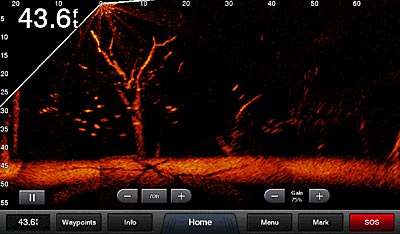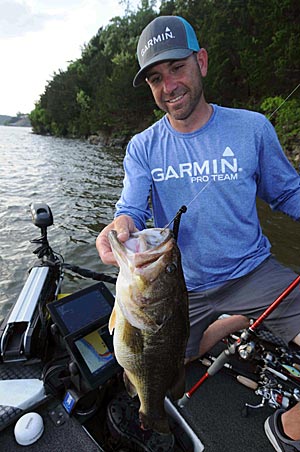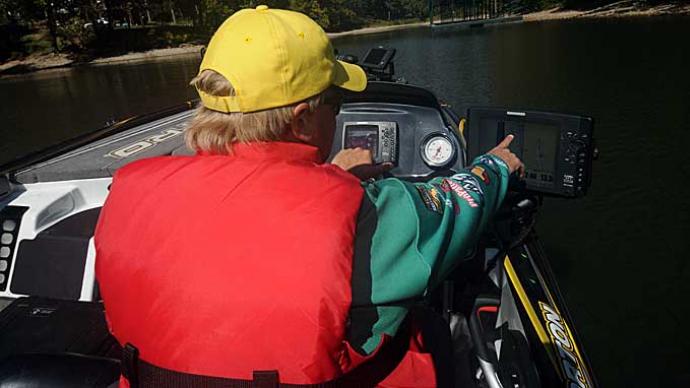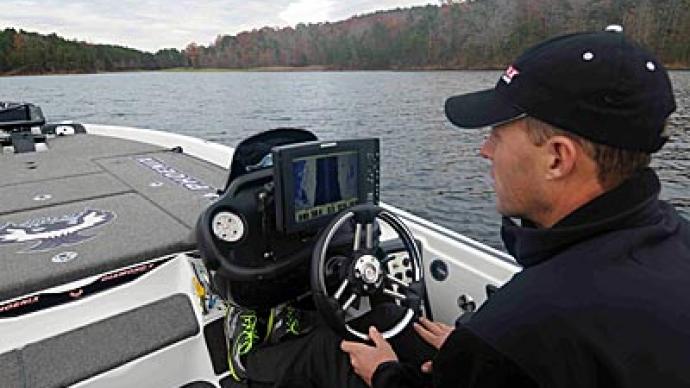
An innovation in electronics played a crucial role in Casey Scanlon’s victory in the 2019 FLW Tour season finale on June 27-30 at Lake Champlain.
Relying exclusively on his Garmin Panoptix LiveScope sonar, Scanlon could scan the vast waters of Lake Champlain and catch a four-day total of 20 largemouth bass weighing 76 pounds, 2 ounces. “I could see the little rock jetties that had points coming out and could pinpoint my casts the first couple of days of the tournament on those points,” Scanlon recalls. “Then, when the fish moved into the grass, I could pinpoint the edges and holes of the grass where I could throw my crankbait or vibrating jig there and reel it through the edges so I wouldn’t get the lures fouled up.”
When targeting the points of the jetties, Scanlon could see bass moving around and chasing bait with the LiveScope sonar. Bass were harder to see with the sonar in the thick milfoil, so he relied on the LiveScope mainly to find the holes and edges of the vegetation.
Garmin Panoptix LiveScope sonar provides both down and forward imaging in one transducer. The LiveScope technology allows anglers to see highly detailed, real-time sonar images of structure, bait, and fish swimming below and around their boat, even when it is stationary.
“It just improves your efficiency on the water,” Scanlon says of LiveScope. “Not only can you see the fish and the cover you are fishing, it just helps direct your cast all day whether you are throwing to a grass line or a brush pile. It is just like fishing shallow out deep. When you are fishing shallow, you can see a lot of the cover you are fishing, and now you can see all the cover under the water with this sonar.”
The FLW Tour pro believes the front imaging of LiveScope helps anglers catch more bass because they can see the fish and objects before the boat moves on top of them. “That is an absolute game-changer,” Scanlon says. “You can see the fish swimming around, the brush and limbs on it, and what direction the brush is facing. With a good cast, you can see fish following your lure back to the boat and know when to stop it. You can also tell when to pull your lure up over a piece of cover. It is just your eyes under water now.”

LiveScope helps Scanlon discern between active and inactive bass by watching their movements on the screen. He also has noticed from watching LiveScope how bass are spooked by noises, such as when he turns on his trolling motor causing the fish to dart.
The LiveScope sonar works for Scanlon in deep and shallow water. Scanlon recalls the FLW Tour event at Lake Chickamauga this year. He could scan underwater stumps in less than 2 feet of water and tell when bass moved up on a shallow hump. “I was able to cast in the direction of the two or three fish that I would see on that particular spot and catch them,” Scanlon says.
The Missouri pro views his LiveScope images with a Garmin GPSMap1040xsv depth finder/chart plotter. Scanlon prefers the 10-inch screen of this unit for easier viewing and recommends any anglers interested in adding LiveScope sonar to a Garmin-compatible depthfinder should get a unit with at least a 9-inch screen.
Scanlon turns his settings on auto, which adjusts the imaging based on the depth of the water. The only setting adjustment he makes is on the range. The unit has a range of 200 feet for front imaging, but Scanlon usually sets his range at 70 to 80 feet for better clarity.
The most significant adjustment Scanlon had to make when he started fishing LiveScope was to avoid fishing everything he saw on the screen. “You see so much in front of you that you can spend so much time fishing for the fish you see under boat docks or on structure,” Scanlon says. While fishing his home waters of Lake of the Ozarks, Scanlon has discovered bass are under every one of the thousands of docks on the lake.
Learning the size of the fish also takes some practice. While testing the sonar with Garmin engineers, Scanlon watched the engineers drop nightcrawlers into a brush pile and catch bluegill. After watching the fish on the screen and catching them, the engineers could figure out the size of the fish they saw with LiveScope. “The engineers then started directing the worm around to the bigger bluegill in that brush pile,” Scanlon says.
The LiveScope down and front imaging allows Scanlon to make successful horizontal and vertical presentations to bass. Some of his favorite tactics for LiveScope scanning are pitching jigs or drop-shotting. He notes a flutter spoon is another lure to try with LiveScope because you can see how the bass react to the spoon as it flutters in front of them. The down imaging also scans a short distance behind the boat as well. “So I can tell when I have passed up that object or the fish,” Scanlon says.
Scanlon noted he relied on the LiveScope sonar to catch bass in almost every FLW Tour event he fished this year. The touring pro finished 27th place at Sam Rayburn by scanning with LiveScope for schools of bass holding in isolated hydrilla clumps. The lake was high, and flooded hay grass made it difficult for Scanlon to run his crankbaits through the vegetation. The LiveScope sonar helped Scanlon determine if the submerged vegetation was hydrilla or saw grass, which helped him avoid the saw grass and key on the hydrilla clumps. His pattern produced a three-day catch of 15 bass weighing 44 pounds, 3 ounces.




